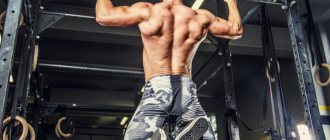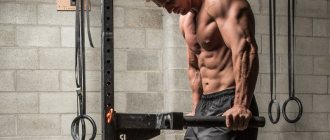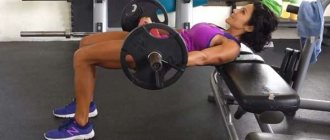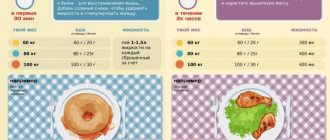Small calorie deficit plus activity
The most important rule in losing weight is fewer calories and more physical activity. Of course, you can lose weight without exercise, but in this case, your chances of losing muscle at the same time increase.
It is impossible to remove fat from one specific area of the body, but you can always reduce the overall percentage of it in the body. It's important to go slowly here because rapid weight loss tends to reduce muscle mass. It is ideal if the weight comes off little by little, even if it takes a year or two.
What's the contradiction?
To lose weight, as you know, the intake of calories into the body should be lower than the expenditure. Schematically speaking, we begin to exercise - we increase calorie consumption. We eat less simple carbohydrates and fats - we reduce intake. In response, the body is forced to take energy - not only for training, but also for everyday life! - from long-lasting reserves, that is, from adipose tissue.
What is the plan for muscle growth? They are formed from proteins. Physical activity (mainly strength) triggers a rather complex chain of biochemical reactions: exercise causes microdamage in the muscles, and in response, hormones and growth factors are produced that literally “repair” damaged cells and stimulate the synthesis of new ones. Now pay attention: new cells are synthesized from protein - which means that a person’s diet after training should contain more protein than usual. And the second point: protein synthesis requires a lot of energy, therefore, the diet should contain a lot of carbohydrates. (I think you now understand why it is physiologically impossible to “pump fat into muscles”? There are no proteins or carbohydrates in fat reserves! Nothing can be “extracted” from them except energy.)
The ideal balance of proteins and carbohydrates is represented by high-carbohydrate protein mixtures (aka gainers), which add 500-800 kcal to your norm. The second option is to make it from low-fat cottage cheese and chicken breasts with rice. The situation is still stalemate. To lose weight you need a deficit of energy, to gain muscle mass you need an excess of it.
Proper nutrition
A high-protein diet is ideal for maintaining muscle mass while losing weight. This is especially important for those over 35 years of age who are losing weight. Most diet plans that work consist of 15-20% protein, 50-60% complex carbohydrates, 25-30% fat.
It is also important to eat foods rich in chromium (tuna, herring, shrimp). A sufficient level of chromium has a positive effect on the feeling of hunger and helps normalize weight.
Pre-workout nutrition
When you feel hungry, you can eat easily digestible, carbohydrate-rich foods. 1.5-2 hours in advance, so as not to feel discomfort and heaviness in the stomach.
Post-workout nutrition
After completing your workout, eat a meal containing protein, slow-digesting carbohydrates, and healthy fats within 45 minutes.
The best proteins for gaining muscle mass:
- any lean meat;
- low-fat dairy products;
- eggs;
- fatty fish;
- seafood;
- protein shakes.
Carbohydrates promote muscle recovery and replenish glycogen reserves. Suitable:
- fruits (especially bananas);
- oatmeal;
- whole grain pasta;
- diet bread;
- Brown rice;
- dark chocolate.
Healthy oils actively replenish energy in the body:
- avocado;
- olive;
- nutty;
- flaxseed and any unrefined oils.
How is fat burned during fasting?
Most of you have heard the expression “fat burns in the flame of carbohydrates.” After all, glucose is a source of energy.
With restrictions on carbohydrate consumption, during weight loss and dieting, glucose burns quite quickly, but since the body needs energy for life, fats are the source of energy.
Accordingly, to start the fat burning process, carbohydrates are needed, which, in turn, after burning, will pull in the fats we don’t need as a source of energy.
You are left wondering, what if the diet is low-carbohydrate, doesn’t it work? However, the catalyst in this case is not carbohydrates, but proteins. This is explained by glucogenesis, a process by which non-carbohydrate compounds are broken down into glucose.
When you use a low-carbohydrate diet, the protein content in your daily diet needs to be increased. Most of the coals will be broken down into glucose and will act as a catalyst for starting the fat burning process.
The remaining percentage will be used to maintain body tone, muscle growth and other processes.
Preserving muscles with training
Exercise is an important aspect of maintaining muscle mass in a calorie-restricted diet. The important thing here is the balance between diet, duration and severity of training. Each body is individual, so it is impossible to accurately predict the amount of effort required to normalize weight. It is worth listening to your body in order to adjust the intensity of your training or diet in time.
The most successful ways to reduce fat while maintaining muscle are:
- Moderate to vigorous cardio, lasting more than an hour and a half PER WEEK . You can choose running, cycling, or any outdoor games.
- Strength training focusing on major muscle groups. Basic exercises that involve 2 or more muscle groups are especially effective. It is important not to overdo it and gradually increase the load and repetitions.
Increasing the intensity of your workouts activates fat burning. Effective strength building is only possible through maximum muscle tension. To balance and restore muscle fibers, alternating periods of rest and exercise is beneficial.
Losing weight and gaining muscle mass: how is this paradox resolved?
The classic sports scheme involves 2 stages. First, against the backdrop of high-intensity training with heavy weights and high-calorie nutrition, we gain both muscle and fat. Then we reduce the working weights and add aerobic exercise, change the diet - and “get dry”, that is, we burn off excess fat and water, preserving muscles.
Using this scheme, you can gain a fairly large amount of muscle tissue - 5-10 kg per year. A person’s clothing size may increase, and body proportions may change. In particular, trousers tailored for ordinary people are always loose in the waist and buttocks, but are difficult to stretch over pumped-up hips, and jackets are narrow in the shoulders and back, but too wide in the abdomen. Such athletes, especially bodybuilders, build muscle mass much more than the physiological norm! This process in sports physiology is called muscle hypertrophy.
But the fact is that most people who come to the gym, especially women, don’t come for it at all! What they call “pumping up” actually does not mean muscle hypertrophy and radical restructuring of the body, but tone and restoration of muscle tissue deficiency.
[new-page]
Research results
The overall decrease in body weight was 2.27 kg over 4 weeks. Athletes with a body fat percentage of 10% or more (abs are already visible, but the muscles are not split) were able to maintain lean muscle mass better than leaner athletes. Levels of testosterone, cortisol and sex hormone binding globulin did not change significantly. It's a good news.
Hormone balance plays a key role in this weight loss formula. Adequate testosterone levels are critical for your body to function properly (not to mention the emotional side of things). The study confirmed that proper testosterone levels in men lead to increased lean muscle mass and decreased fat and help increase libido.
But that is not all. Reducing body fat mass in combination with adequate hormone levels is not all that this diet has to offer. Participants who were in the fast fat burning group were even able to improve their performance in sports.
Long jumpers were able to improve their performance, and sprinters were able to reduce the time it took them to run the distance. This indicates an increase in the relative strength of athletes. Indeed, you can jump further and run faster when you don't have excess fat, which is extremely important for sports where you need to move your own body weight.
To summarize the study, we see that reducing caloric intake by 24% by reducing carbohydrate intake and increasing protein resulted in a loss of 567 grams of fat weekly, without negatively affecting muscle or hormone balance, while improving performance. In this way, you can burn fat, not muscle, by maintaining the correct proportions of BJU while maintaining a calorie deficit.
Diet phase
Using the value of 2257 kcal per day, the diet should consist of:
40% calories from protein
- 2257 x 0.4 = 903 kcal
- One gram of protein contains 4 kcal, therefore, 903 / 4 = 226 grams of protein.
This means you need to consume 226 grams. protein per day.
30% calories from carbohydrates
- 2257 x 0.3 = 677 kcal
- One gram of carbohydrates contains 4 kcal, therefore 677 / 4 = 169 grams of carbohydrates
This means you need to consume 169 grams. carbohydrates per day.
30% calories from healthy fats
- 2257 x 0.3 = 677 kcal
- One gram of fat contains 9 kcal, therefore 677 / 9 = 75 grams of fat
You should consume 75 grams. fat per day.
Let's combine the obtained data:
- 2257 kcal per day;
- 226 gr. protein per day;
- 169 gr. carbohydrates per day;
- 75 gr. fat per day.
You can add one or two fasting weeks depending on how long you've been on the diet and how you feel overall. Monitor your changes and increase your calorie intake if you lose more than one kilogram per week after the first two weeks of following the program.
Remember, rapid loss of fat mass can also cause muscle loss, which is clearly the opposite of what you want. This fat loss program is designed to minimize muscle loss and changes in hormone levels to help maintain your athletic performance.
Where is the proof?
Many people are familiar with the effect of the first months in a fitness club: clothes fit looser, waist and hip measurements in centimeters decrease, but weight in kilograms does not change. This is precisely an indicator that muscle mass is growing: it is 30% heavier than fat. After several years of a sedentary lifestyle, muscles can grow even from workouts that are not intended for such a gain at all: running, aerobics, cycling.
Of course, it makes no sense to compare such an increase in muscle tissue in absolute numbers (centimeters in the biceps, kilograms) with the hypertrophy that we see in bodybuilders and related sports. As a rule, clothing sizes do not increase. Accordingly, recovery to normal is more noticeable.
In general, if you are involved in fitness and stick to proper nutrition for about a year, the trend of “losing weight and building muscle at the same time” is no longer a threat to you. This is only available to beginners after a sedentary lifestyle.
Muscle hypertrophy
To begin with, let’s understand in general terms what gaining muscle mass is. This means muscle hypertrophy, that is, an increase in muscle thickness.
The number of muscle fibers in a person is determined genetically and does not change over life. Therefore, muscle growth occurs at the cellular level, due to the components of the muscle cell: contractile units of myofibrils and/or the amount of sarcoplasm. Sarcoplasm is the semi-liquid content of a muscle cell, which contains energy resources - mitochondria, as well as reserves of creatine phosphate, glycogen, etc.
Sarcoplasmic hypertrophy does not provide a large increase in muscle volume, but it does provide an increase in muscle endurance. This type is predominantly developed in track and field athletes.
Muscle growth due to myofibrils , on the contrary, provides a more significant increase in muscle volume, which allows one-time maximum effort. This type is typical for athletes who engage in weightlifting, where short-term “jerks” are required, for example, lifting a barbell.
However, with any training, both of these types of muscle development are involved to one degree or another.
The process of muscle growth is influenced by a number of factors:
1. Mechanical load. Training leads to muscle microtrauma, which allows you to start recovery processes and stimulate growth. In addition, as a result of stress, creatine and lactic acid accumulate in the muscles, which also affect muscle growth.
2. Amino acids. The building material for muscles is proteins, or more precisely, the amino acids that make up proteins. If there is a deficiency of amino acids in the body, then muscles will not grow.
3. Hormones. Gaining muscle mass is influenced by the growth hormone somatotropin, as well as testosterone and insulin.
4. Age. After 25-35 years, the level of growth hormones decreases. At the same time, the susceptibility of muscle cells to growth stimuli decreases.











